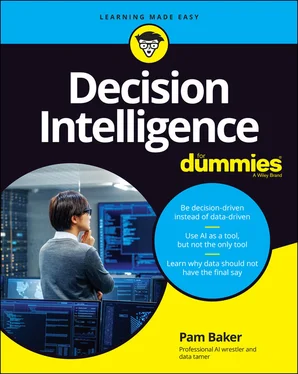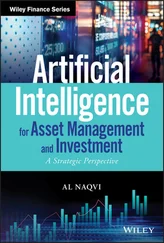AI is set to continue to serve in this and other automated roles for the foreseeable future. As a technology, it will continue to improve as all technologies do, but placing it within a decision intelligence framework means that its performance will improve exponentially because it is given not only rules to follow but also a target to aim at. Its tasks will be set upon a path of specific actions necessary for creating a specific business impact, and it will faithfully pound away at these tasks until its model decays or someone makes a new model to create another path leading to another targeted impact.
 Other technologies, such as robotic process automation (RPA) and application programming interfaces (APIs), integrate processes. (RPAs are now called virtual workers because they mimic how human workers work, including interacting with user interfaces in the same way.) As RPAs continue to automate processes that were previously difficult to automate, AI can be added to make some automated decisions affecting these processes as well. In other words, the whole of technology engaged in decision making is getting smarter and better and more able to work together.
Other technologies, such as robotic process automation (RPA) and application programming interfaces (APIs), integrate processes. (RPAs are now called virtual workers because they mimic how human workers work, including interacting with user interfaces in the same way.) As RPAs continue to automate processes that were previously difficult to automate, AI can be added to make some automated decisions affecting these processes as well. In other words, the whole of technology engaged in decision making is getting smarter and better and more able to work together.
All this might sound like a setup for a dystopian science fiction movie, but in reality, these developments are nothing to fear. In decision intelligence, whichever technologies you end up using are chosen specifically to augment human soft skills, like creative problem solving, critical thinking, empathy, emotional intelligence, creative design, creative disruption, intuitive intelligence, and intuitive decision making — skills considered nearly impossible to mimic and automate. Even gut instinct can be considered a soft skill, and it too is well out of AI’s reach. What ends up happening in decision intelligence is that all human strengths attributable to good judgment and smart decisions are by necessity added to the mix.
 AI is better cast in the role of sidekick, where it augments human decisions rather than dictates or directs them. The same is true of analytics tied to other automated processes as well.
AI is better cast in the role of sidekick, where it augments human decisions rather than dictates or directs them. The same is true of analytics tied to other automated processes as well.
Much of the decision intelligence revolution is happening out of the end user’s line of sight, but there’s one place where anyone can see the changes unfolding: AI digital assistants such as Google Assistant, Alexa, and Siri. Watch closely as they move from giving you facts in response to your questions to making unprompted recommendations based on your behavior and moods.
Fact reporting such as, “Here are pharmacies near you” or “The name of that song is ABC” will begin to shift to customized and unprompted recommendations. They may look and sound something like this: “XYZ Restaurant has added one of your favorite dishes to its menu. Would you like for me to book the opening in the reservation schedule on Thursday at 7pm and put it on your calendar?” Or, it may say something like this: “Would you like for me to place your favorite coffee order for the pickup window? The one a block from your meeting place has less than a 10 minute wait.”
The AI assistant will also produce files for meetings and other handy actions as the user moves through their day. As sidekicks in a user’s personal and professional life, the augmented activities will be far more productive than had the human personally tended to all the details and micro decisions.
In digital decision-making, AI will improve at everything it now does — and then some. For example, it will improve at writing algorithms to rapidly meet an organization’s or researcher’s desired outcomes. That means that, for today and far into the future, AI will be in a position to continue its role as sidekick, producing everything you need to win the day. It’s unimaginable that AI won’t have some role, small or large, in most Decision Intelligence processes.
Seeing How Decision Intelligence Looks on Paper
Though the decision intelligence framework is perfect for guiding AI to consistently produce business value for you, the methodology can be used with no digital data or machines. For example, you can use AI to make decisions on a spreadsheet, on the back of a napkin, on a single sheet of paper, or even on a wall (using a crayon, of course). That’s because the process you use is up to the decision-maker to choose. The Decision Intelligence process itself can be quick and short, or it can be quite complex and take some time to complete. You may want to start with a SWOT table listing the S trengths, W eaknesses, O pportunities, and T hreats when making your initial decision. From there, you can determine the steps you need to take to make your decision render a desired impact in the real world.
The process is similar to determining a destination and then mapping out the best route between where you are and where you want to be. It’s the impact you desire, however, that will define which route is best. Need to be there fast? The direct route is best. Want to see more along the way or stop at tourist attractions? Then a scenic route is the best way. Want to use your hotel rewards points or your gas rewards card on the trip? Then mapping a route based on the location of certain hotel and gas brands is the best route.
 In decision intelligence, the impact always matters most, for it is the manifestation of your decision.
In decision intelligence, the impact always matters most, for it is the manifestation of your decision.
Working within a decision intelligence framework forces you to become more aware of how the decision-making process works. For example, many of the mental processes you use are intuitive — that's what makes it possible for you to come to conclusions quickly. But make no mistake: Whether you realize it or not, your brain is calculating the same mathematical formulas as a machine would use to help you reach the same conclusions. There’s a simple reason for that: Machines copy how people think. As such, machines are definitely the sidekicks in decision intelligence processes, there to assist and augment your efforts.
 Superheroes don’t always need a sidekick, and you won’t either. Choose the processes, tools, and information according to the needs in executing your decision. Don’t default to the technologies and queries with which you’re most familiar. The point is not to repeat the same acts, but rather to produce consistent value in personal, professional, or digital decisions.
Superheroes don’t always need a sidekick, and you won’t either. Choose the processes, tools, and information according to the needs in executing your decision. Don’t default to the technologies and queries with which you’re most familiar. The point is not to repeat the same acts, but rather to produce consistent value in personal, professional, or digital decisions.
You may be wondering how the processes in decision intelligence differ from those used in data analytics. After all, it’s obvious that decisions are also made first when using data analytics in the usual way. For example, someone decides what the business rules are before they apply them to data analytics or AI. Someone also decides what data to use, what data sources to join, and what queries to make. Further, someone decides what projects to launch and whether to send them to production. And so on.
With all these decisions upfront, what does “Put the decision first” in decision intelligence mean? And how does it change anything? It helps to remember that the process in machine-based decision-making is linear, meaning that it moves consecutively from data preparation and selection to algorithm inputs and, finally, to an output. The output is typically an insight or a recommendation delivered as a visualization, as narrative text, or as both, from which a human can decide what action to take. Sometimes, the output is connected to an automated process that then takes an action as directed by the output.
Читать дальше

 Other technologies, such as robotic process automation (RPA) and application programming interfaces (APIs), integrate processes. (RPAs are now called virtual workers because they mimic how human workers work, including interacting with user interfaces in the same way.) As RPAs continue to automate processes that were previously difficult to automate, AI can be added to make some automated decisions affecting these processes as well. In other words, the whole of technology engaged in decision making is getting smarter and better and more able to work together.
Other technologies, such as robotic process automation (RPA) and application programming interfaces (APIs), integrate processes. (RPAs are now called virtual workers because they mimic how human workers work, including interacting with user interfaces in the same way.) As RPAs continue to automate processes that were previously difficult to automate, AI can be added to make some automated decisions affecting these processes as well. In other words, the whole of technology engaged in decision making is getting smarter and better and more able to work together.










